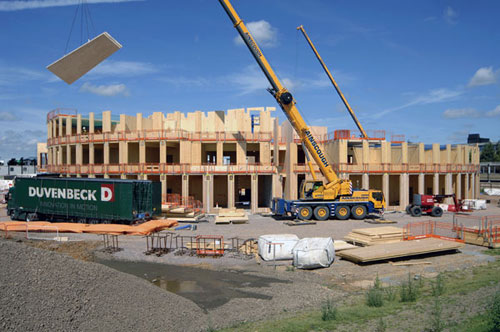Materials In Action
In California’s 1994 Northridge earthquake, where peak ground accelerations nearly broke records and were considerably higher than codes specified, many large structures collapsed. At a hearing before the U.S. House of Representatives by the Committee on Space, Science and Technology, a reason given for relatively limited death and damage toll was “The earthquake occurred at 4:31 a.m., when the majority of people were sleeping in their wood-frame, single-family dwellings, generally considered to be the safest type of building in an earthquake."7
In that same earthquake, many welded steel moment frame buildings, which appeared to be earthquake-proof, were damaged, prompting the Federal Emergency Management Agency to initiate new design approaches that would minimize future seismic damage. As a consequence, all pre-qualified connection details and design methods contained in the building codes of that time have been rescinded, with new provisions stipulating that new designs be substantiated by testing.
In 2008, an earthquake struck Wenchuan, China, claiming the lives of hundreds of thousands of people. Most of the buildings that collapsed or sustained structural damage were masonry or concrete structures. In comparison, the few wood-frame houses within the earthquake region performed well, with some not even sustaining superficial damage. The seismic performance of the wood-frame buildings prompted the building of multi-story wood-frame buildings within the earthquake area as demonstration projects.8
Materials in the Construction Phase
Because of its high strength-to-weight ratio, steel framing is easy to handle on site and can take less framing material than wood for an equal size structure. Steel can be manufactured to specific lengths minimizing jobsite scrap and, because it does not warp or split, the use of steel eliminates the need to sort out poor quality product. Builders are increasingly using panelization—either building panelized components themselves or purchasing pre-assembled wall, floor and truss components—which reduces construction time and costs. Prefabricated steel structures can be lifted into place with cranes and bolted together, for relatively quick building erection.
 |
CLT panels were used on site to build Norwich Academy in the UK. Architect: Sheppard Robson Photo courtesy of Kier Contractors |
According to the Reinforced Concrete Construction Committee, cast-in-place concrete can reduce project startup time and start-to-finish time compared with steel. Materials can be ordered for just-in-time delivery from local suppliers as opposed to steel, where pre-ordering and long lead times are common. Concrete industry data claim that the ready availability of concrete can save up to 20 weeks or more from notice-to-proceed to the start date and that, once construction begins, 13 percent fewer delays are reported during framing compared to steel.9









